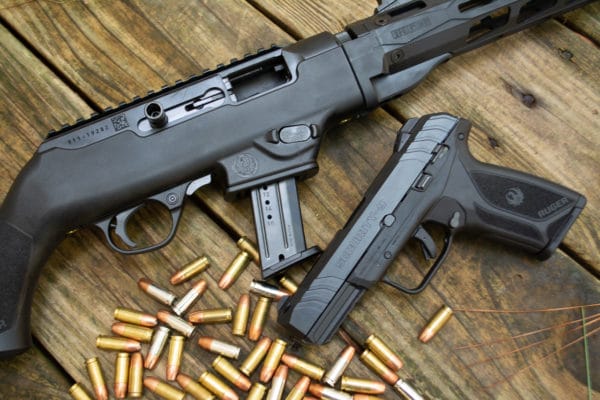
If you’re looking for “most powerful” then you’d always choose a rifle caliber over a pistol carbine and a carbine over a pistol thanks to the higher velocity of any given load through a carbine. On the other hand, a decision regarding the “right” firearm choice usually involves a variety of categorical pros and cons. Here are some factors beyond raw power that may influence your decision.
Ease of Aim
It seems intuitive that it’s easier to shoot accurately with a carbine or rifle than a pistol and the science supports this assumption.
Longer sight radius allows more precision in sight picture while being far more forgiving of slight sight misalignments. If the front and rear sights are three inches apart, a slight movement of one sight results in a big miss downrange. If the front and rear sights are 12 inches apart, as they are on the Ruger PC Carbine shown here, that same amount of movement results in a much smaller variance downrange. Stated differently, you can make a more dramatic mistake and still hit when using a firearm with a longer sight radius.
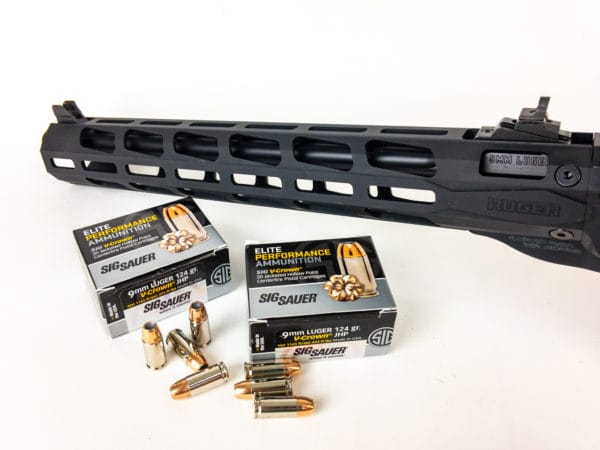
The other aiming factor is trigger control. The key to shooting any firearm well is to press the trigger without moving the gun. When shooting a one-pound pistol and a 5.5-pound trigger, it takes skill to do this consistently. When applying 5.5 pounds of pressure, that one-pound pistol wants to move. When shooting a 7.75-pound carbine, the same 5.5-pound trigger weight doesn’t create nearly the same impact on sight picture alignment. This is one of the lesser-known reasons that rifles are so much easier to shoot well than handguns.
Live Inventory Price Checker

|
Ruger Pc Carbine 9mm 16'''' Bbl 10rd Black - Ruger Pc Carbine 9mm 16 Bbl 10rd Black | Brownells.com | $ 669.99 |
|
|
|
Ruger PC Carbine 9mm Magazine - Ruger PC Carbine Polymer | Ammunition Depot | $ 23.99 |
|
|
|
Magpul Industries PC Backpacker Stock, Stock, Ruger PC Carbine, Black | Palmetto State Armory | $ 193.99 $ 142.99 |
|
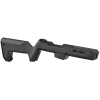
|
Magpul Industries PC Backpacker Stock, Stock, Ruger PC Carbine, Black | Palmetto State Armory | $ 193.99 $ 142.99 |
|
Recoil
One big benefit to a pistol caliber carbine is control, thanks to lower felt recoil levels. How low? What you feel as you shoot depends largely on the weight of the firearm. The energy backward is always the same because the action of launching a bullet and powder charge of a certain weight generates an equal and opposite reaction in your direction. However, you’ll feel more force when shooting a light firearm than when firing a heavy one. Picture in your head the recoil of a 9mm round fired from a two-ounce carbon-fiber pistol. Now, think about mounting a 9mm barrel to a tank and shooting that. The recoil energy is the same, but if you put your shoulder against the back of the tank, you won’t feel the recoil.
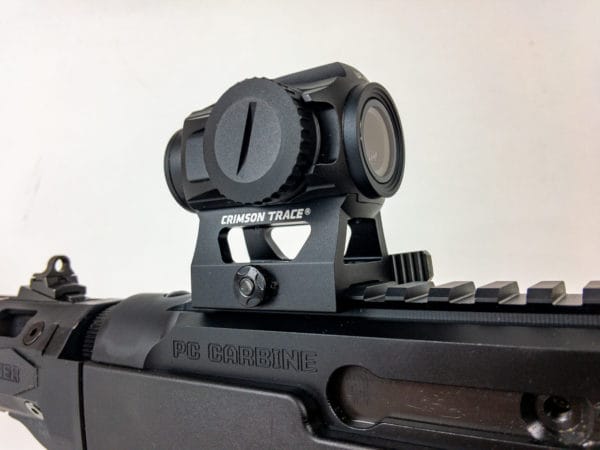
The Ruger PC Carbine shown here weighs in at 7 ¾ pounds. That’s empty, with a standard 17-round magazine installed and topped with the Crimson Trace CTS-1000 red dot sight and mount. A pistol I’m testing now, the Sig Sauer P320 XCompact equipped with an adapter plate and Trijicon RMR red dot sight, weighs 1.5 pounds. If we do the recoil math assuming we’re firing the Federal Premium 124-grain HST load, the pistol delivers 4.76 foot-pounds of recoil energy with its muzzle velocity of 1,138 feet per second. Even with its higher velocity of 1,264.3 fps, the PC Carbine generates just 1.14 foot-pounds of recoil energy.
Just as a comparison, a standard AR-type rifle firing a 55-grain .223 Remington cartridge will thump you with about 4.67 foot-pounds of recoil, assuming you’re shooting a seven-pound rifle. Clearly, few would classify 9mm handguns and AR rifles as having “heavy recoil” so we’re just pointing out the differences to a pistol carbine.
Penetration Issues
Here’s a deciding factor that defies intuition. Most people assume that pistol calibers are far “safer” from a penetration perspective. For home defense applications, most people I speak with will choose a pistol caliber option over an AR-15 because the AR will “penetrate everything.”
This is not technically true. In general, rifle calibers will penetrate all sorts of materials. However, the standard .223 Remington 55-grain FMJ load uses a small and light bullet traveling at high velocity. It quickly begins to tumble and fragment when it hits objects like drywall. A 9mm, .40, or .45 ACP bullet tends to continue going on about its business with little visible course change or tumble. Of course, bullet design matters, so results vary with specific load choices. Varmint loads also fragment quickly, while expanding mushroom bullets do not.
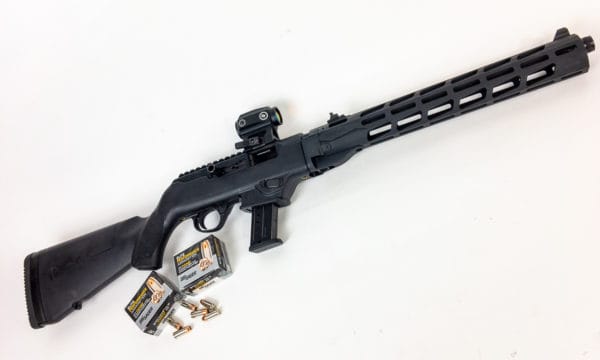
Considering those caveats, a standard 55-grain FMJ load fired from an AR-type will penetrate fewer layers of drywall than most pistol rounds and buckshot loads. Yes, I’ve built fake walls, taken them to the range, and shot them full of holes with all sorts of pistol, shotgun, and rifle loads.
Here’s the bottom line. While an AR may penetrate fewer walls than a pistol-caliber bullet, it may not matter in a practical sense. Pistol bullets will go through five double-layer walls (the most I’ve tried) with ease. Most 55-grain .223 FMJ and varmint bullets will also penetrate four or five wall sets, although they start to veer off course, tumble, fragment, and lose speed after the second set of walls. So, does it matter? Probably not. Whatever you’re shooting, bullets that pass through interior or exterior walls are your responsibility. If you favor an AR for home use because of lower penetration, you’re right. It does have less wall penetration risk. The question is whether that’s relevant considering that both a pistol carbine and AR will go through several before stopping.
Range
Even with increased velocity resulting from longer barrel length, pistol calibers drop like rocks as they fly. While a rifle round can travel miles, a pistol round can do no such thing. The large diameter, short length, and lower ballistic coefficient mean that they fly almost as well as penguins wearing waders. Let’s look at the math.
If we zero a .223 Remington and 9mm pistol carbine at 50 yards and use the same optics on each, we’ll see the following flight paths.
| Distance | 9mm Carbine Bullet Drop (inches) | .223 Remington Bullet Drop (inches) |
| 50 yards | 0 | 0 |
| 100 yards | 3.81 | 1.72 |
| 200 yards | 36.04 | 1.37 |
| 300 yards | 108.40 | 5.26 |
| 400 yards | 229.58 | 20.11 |
| 500 yards | 408.95 | 45.83 |
Clearly, a 9mm carbine isn’t intended to be a “several hundred-yard” firearm – we’re just showing the numbers to illustrate how aggressively a pistol round dives toward the ground relative to a rifle projectile. If you’re worried about errant shots flying to distant and unknown destinations, a pistol carbine may be something to consider.
Noise Level
For most any imaginable application, less noise is generally a good thing. With far lower operating pressures in the 17,000 to 35,000 operating range, most pistol calibers are quieter than rifle calibers which routinely operate in the 50,000 psi give or take range. For example, from a pistol, a 9mm generates about 158 dB. A .223 Remington AR-type rifle creates 164 dB. Keep in mind that decibels don’t follow normal numerical measurements; they work on a logarithmic scale. That means that 164 dB is not just 4% louder. In fact, a rule of thumb is that every three, yes just three, decibels represent a doubling of sound level. So, a pistol caliber is much, much quieter than a rifle caliber, all else being equal.
But what about pistols versus carbines? The longer barrel length helps as expanding gas has more opportunity to “chill out” and create less noise at the muzzle. As one example, a Tommy Gun .45 ACP has been measured at 151 dB while most .45 pistols operate in the 157-dB range.
Handgun Compatibility
At least in theory, there’s an interesting benefit in that not only ammunition but magazines can seamlessly move back and forth between pistols and carbines. For example, the Ruger PC Carbine shown here can use Glock or Ruger pistol magazines depending on what carbine magazine adapter you have installed.
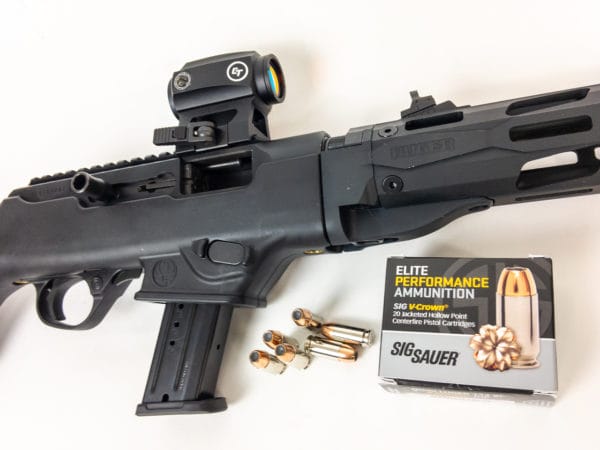
I only say “in theory” because for a civilian or home-defense application, I don’t know of a case where someone prevailed because they were able to move a loaded magazine from one to the other in a pinch. However, it’s hard to argue with the logistical convenience.
So, the bottom line? These types of carbines are not only easy but fun to shoot. Their low noise and gentle recoil make them great firearms for younger and less experienced shooters, but their capabilities can also make them equally valuable for experienced users.
About
Tom McHale is the author of the Practical Guides book series that guides new and experienced shooters alike in a fun, approachable, and practical way. His books are available in print and eBook format on Amazon. You can also find him on Facebook, Twitter, Instagram and Pinterest.





2 ways the Ruger PC Carbine can improve (1 aftermarket and 1 Ruger driven)
Aftermarket: companies ought to offer aftermarket interchangeable magazine wells to accommodate more than just Ruger or Glock double stack magazines. Imagine a customer being able to purchase an aftermarket that will work with his/her double stack 9mm mag (Sig, S&W, CZ, XD, etc.) Ruger Driven: Imagine a Ruger PC Carbine in 10mm that takes Ruger 10mm 1911 magazines and Glock (or XD) 10mm double stack mags….. That gun would hunt (wild boar and whitetail deer, etc) and defend (from bears and/or 2 legged predators).
Always a good idea to have a rifle that shoots pistol ammo. You get more range, more power, better accuracy over longer distances. I grew up in Az. so, when I was old enough I bought a marlin 94 in 44 mag and then a S & W 29 in 44 mag. Very akin to the reasoning that was used to tame the western U.S. There is nothing in Az. that either wont handle. The idea of a semi auto rifle in a pistol caliber has the same benefits (minus the recoil of the ole 94) and should you find… Read more »
Another advantage of a 9mm carbine is the cheap ammo allows more practice shooting it.
Plus PCC are just plain FUN.
Being “Old School” (okay, just old), I’ve had handgun/rifle combinations for years and enjoyed them immensely for target shooting, plinking and hunting. My guns are in .357 (Blackhawk & Marlin) and .44 Magnum (Super Blackhawk, Redhawk & Winchester ’94). It’s an idea that goes back to 1873 when Winchester introduced the Model 1873 in the same calibers that Colt had introduced in his Revolvers. It was a good idea then as it is today.
I enjoyed the article. Thank you. Just want to note that the bullet drop chat looks wonky for the .223 at 200 yards. It is less than the 100 yard figure.